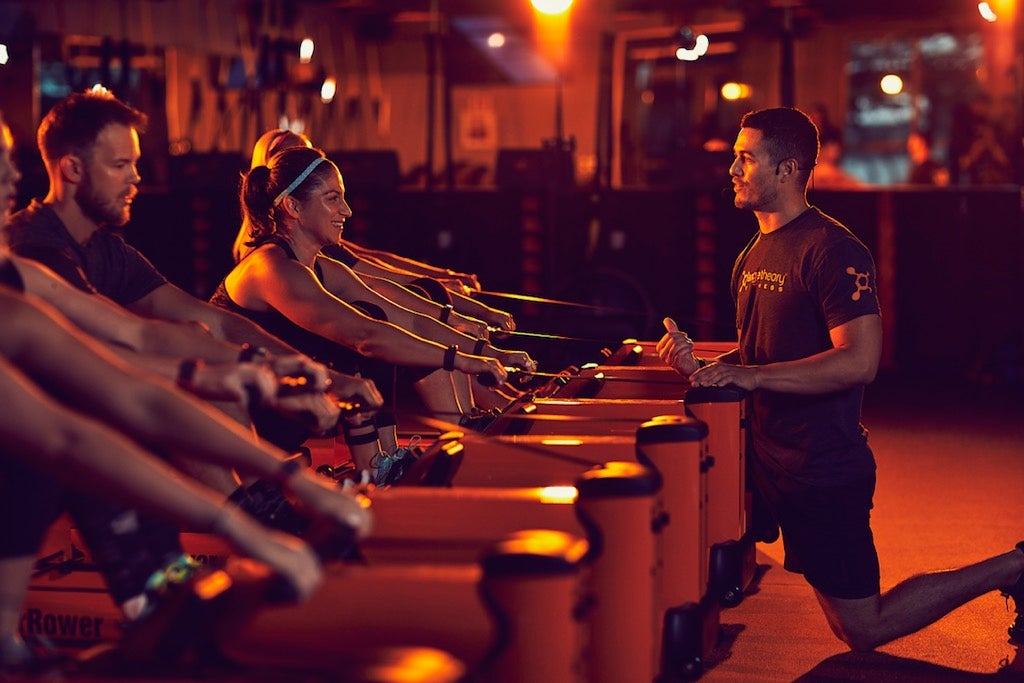Should Triathletes Try Orangetheory?

The high-intensity studio workout has exploded in the past few years. Our editor hit up the popular franchise to see what all the fuss is about—and if the classes can fit into a tri training regimen.
Odds are you’ve driven (or biked or ran) by one of the hundreds of Orangetheory Fitness studios around the world—there are nearly 1,000 in the 49 U.S. states and 17 countries—and it’s piqued your interest. But as triathletes we already balance swim, bike, and run—so is there room or reason to try this unique one-hour studio workout? To find out, we jumped into several classes and chatted with Orangetheory director of fitness Michael Piermarini, a former competitive triathlete, about the ins and outs of the fitness franchise’s popular workouts.
How it Works: You’ll show up for a class lasting approximately 60 minutes. The class will be a heart-rate based workout, so you’ll wear a heart rate-monitor (there are chest-, wrist- and arm-based options; you’ll be given one to use in your trial session and then you’ll have to purchase one).
The session is based on the goal of getting 12 or more minutes (or splat points) in the “orange zone,” or 84 percent or greater of your max heart rate. Everyone’s heart rates are displayed on televisions throughout the studio with bright colors showing what zone they’re in. After a quick warmup on either the treadmill or the rower, the treadmillers stay on the treadmill and the rowers head over to the weight room. Runners (or power walkers) are told to work at their base, push, or all out paces (as described by the trainers) in intervals that generally range from 30 seconds to three minutes (intervals can also be distance-based). The other half of the class is given a strength session made up of dumbbell, bodyweight, TRX, and sometimes band work. Some rowing always comes into play either within the treadmill or weight room blocks. Sometimes the workout is straight half weight room and half treadmills, and sometimes the 60 minutes is spent going back and forth. This element of surprise is one of the core components of the program; you’ll never experience the same workout twice.
Pros for Triathletes
1. It Will Teach You How to Properly Strength Train
If you’re new to strength training, or generally know that you should be doing more of it, a program like this is a great place to start. A television on the wall shows a model demonstrating each exercise, with specific sets and reps. A coach is on hand to show every exercise and make sure that every participant is using the proper form. “We’re so focused on endurance, endurance, endurance, that we don’t take into account that there is a huge strength and core component to triathlon as well,” says Piermarini.
2. It Can Be an Invigorating Change of Pace
The music, the guided instruction, the camaraderie, the quick pace, and a bit of competition can be a nice break from traditional swim-bike-run training—especially if you tend to train alone. “There is a huge component that is not only physical, but mental when it comes to cross training,” says Piermarini. “Mixing up the variety of the workouts can be a huge advantage. You’ll feel refreshed next time you’re out on your long run.”
3. Rowing = Triathlon Strength
We’ve documented the benefits of the rower before, and Orangetheory is a nice alternative to jumping on the rower at the gym with no planned session or goals. Rowing properly is more technical than many athletes realize, so having a coach on hand to teach how to do it is helpful. “We refer to the rower as the ultimate calorie burner,” says Piermarini. “It activates over 80 percent of your muscle groups. It uses your core, your legs, and your arms. When we think about triathlon, those are really the key components of where you need to be strong for swim, bike, and run. It’s a compound exercise where you get the biggest bang for your buck.”
RELATED: What Happens When a Pro Triathlete Tries 7 Fitness Trends?
Potential Cons
If you’re going to add something like this (or any other fitness program—even yoga) to your triathlon training plan, it’s important to pay attention to the bigger picture. “The mentality really has to be that it’s not in addition to, but it’s something you supplement with,” says Piermarini. “If you have a hill day on the calendar and you come into Orangetheory and it’s a strength day with hills [on the treadmill], then take that into account.”
In other words, you’ll have to be flexible and proactive about your program design to make classes like these work (i.e. classes where you can’t predict what’s coming). For example: You may not need to do your planned hilly workout if you just did hills in your Orangetheory class. You’ll have to listen to your body—and communicate with your coach, if you have one—to determine the best way to fit in the sessions. If you like to solidly stick to a plan, adding Orangetheory may not be your cup of tea.
The Nitty Gritty
The cost can vary a bit by location, but generally a one-month membership ranges from four classes ($59) to unlimited ($159). Piermarini says the sweet spot for most triathletes will be about two times per week, making the eight-class option ($99) ideal. One membership gets you into every Orangetheory studio there is, so it’s easy to drop in on a class no matter where you go—and get the same experience you’re used to at your home studio.